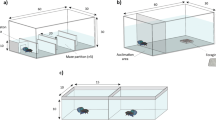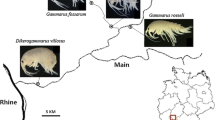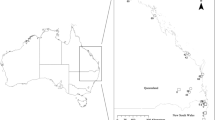Abstract
The behavioural trait axes of activity, exploration, boldness and sociability can help to understand the tendency of an invasive species to disperse, as may be expected at the fringe of an invasive population, or to socialise, as may be expected in well-established populations where densities of invaders are typically high. We compared behavioural traits between the gammarids Dikerogammarus villosus and Gammarus pulex from centre and fringe populations at Barton Broad, Norfolk, UK. Dikerogammarus villosus is invasive in Western Europe and has displaced many macroinvertebrate species, including the native G. pulex. Gammarus pulex is itself invasive in Northern Ireland and the Isle of Man, thus its displacement increases interest into what unique characteristics of D. villosus make it a dominantly successful invader. Dikerogammarus villosus was significantly less active, less explorative, and more social than G. pulex. We found no significant differences in the behaviours of D. villosus individuals from the central population and the invasive fringe. These patterns indicate active dispersal is likely important to the invasion success of G. pulex, while D. villosus might depend on passive movement. Our data suggest that behavioural factors determining invasive success within closely related taxa can differ considerably, and may lead to different patterns of invasion.




Similar content being viewed by others
References
Boets P, Lock K, Messiaen M et al (2010) Combining data-driven methods and lab studies to analyse the ecology of Dikerogammarus villosus. Ecol Inform 5:133–139
Bojko J, Stebbing PD, Bateman KS et al (2013) Baseline histopathological survey of a recently invading island population of ‘killer shrimp’, Dikerogammarus villosus. Dis Aquat Org 106:241–253
Bollache L, Devin S, Wattier R et al (2004) Rapid range extension of the Ponto–Caspian amphipod Dikerogammarus villosus in France: potential consequences. Archiv Für Hydrobiol 160:57–66
Boon AK, Reale D, Boutin S (2008) Personality, habitat use, and their consequences for survival in North American red squirrels Tamiasciurus hudsonicus. Oikos 117:1321–1328
Briffa M, Dallaway D (2007) Inter-sexual contests in the hermit crab Pagurus bernhardus: females fight harder but males win more encounters. Behav Ecol Sociobiol 61:1781–1787
Brodin T, Drotz MK (2014) Individual variation in dispersal associated behavioral traits of the invasive Chinese mitten crab (Eriocheir sinensis, H. Milne Edwards, 1854) during initial invasion of Lake Vänern, Sweden. Curr Zool 60:410–416
Chapple DG, Simmonds SM, Wong BB (2011) Know when to run, know when to hide: can behavioral differences explain the divergent invasion success of two sympatric lizards? Ecol Evol 1:278–289
Chapple DG, Simmonds SM, Wong BBM (2012) Can behavioral and personality traits influence the success of unintentional species introductions? Trends Ecol Evol 27:57–64
Coats J, Poulin R, Nakagawa S (2010) The consequences of parasitic infections for host behavioural correlations and repeatability. Behaviour 147:367–382
Cote J, Fogarty S, Weinersmith K et al (2010) Personality traits and dispersal tendency in the invasive mosquitofish (Gambusia affinis). Proc R Soc B Biol Sci 277:1571–1579
Cote J, Fogarty S, Tymen B et al (2013) Personality-dependent dispersal cancelled under predation risk. Proc R Soc B Biol Sci 280:20132349
Devin S, Piscart C, Beisel JN et al (2004) Life history traits of the invader Dikerogammarus villosus (Crustacea: Amphipoda) in the Moselle River, France. Int Rev Hydrobiol 89:21–34
Dick JTA (2008) Role of behaviour in biological invasions and species distributions; lessons from interactions between the invasive Gammarus pulex and the native G. duebeni (Crustacea: Amphipoda). Contrib Zool 77:91–98
Dick JTA, Platvoet D (2000) Invading predatory crustacean Dikerogammarus villosus eliminates bath native and exotic species. Proc R Soc Lond Ser B Biol Sci 267:977–983
Dick JTA, Montgomery I, Elwood RW (1993) Replacement of the indigenous amphipod Gammaurs duebeni celticus by the introduced Gammarus pulex—differential cannibalism and mutual predation. J Anim Ecol 62:79–88
Dodd JA, Dick JA, Alexander ME et al (2013) Predicting the ecological impacts of a new freshwater invader: functional responses and prey selectivity of the ‘killer shrimp’, Dikerogammarus villosus, compared to the native Gammarus pulex. Freshw Biol. doi:10.1111/fwb.12268
Duckworth RA, Badyaev AV (2007) Coupling of dispersal and aggression facilitates the rapid range expansion of a passerine bird. Proc Natl Acad Sci USA 104:15017–15022
Dytham C (2011) Choosing and using statistics: a biologist’s guide. Wiley, Chichester
Fisher JDL, Mushet DM, Stockwell CA (2014) Potential for parasite-induced biases in aquatic invertebrate population studies. Hydrobiologia 722:199–204
Fogarty S, Cote J, Sih A (2011) Social personality polymorphism and the spread of invasive species: a model. Am Nat 177:273–287
Forsman A, Wennersten L, Karlsson M et al (2012) Variation in founder groups promotes establishment success in the wild. Proc R Soc B Biol Sci 279:2800–2806
Gallardo B, Paz Errea M, Aldridge DC (2012) Application of bioclimatic models coupled with network analysis for risk assessment of the killer shrimp, Dikerogammarus villosus, in Great Britain. Biol Invasions 14:1265–1278
Gherardi F, Aquiloni L, Tricarico E (2012) Behavioral plasticity, behavioral syndromes and animal personality in crustacean decapods: an imperfect map is better than no map. Curr Zool 58:567–579
Gosling SD (2001) From mice to men: what can we learn about personality from animal research? Psychol Bull 127:45–86
Hayes KR, Barry SC (2008) Are there any consistent predictors of invasion success? Biol Invasions 10:483–506
Holmes JC, Bethel WM (1972) Modification of intermediate host behaviour by parasites. In: Canning EU, Wright CA (eds) Behavioural aspects of parasite transmission. Academic Press, London, pp 123–149
Kappes H, Stoll S, Haase P (2012) Differences in field behavior between native gastropods and the fast-spreading invader Arion lusitanicus auct. non MABILLE. Belg J Zool 142:49–58
Keane RM, Crawley MJ (2002) Exotic plant invasions and the enemy release hypothesis. Trends Ecol Evol 17:164–170
Kinzler W, Kley A, Mayer G et al (2009) Mutual predation between and cannibalism within several freshwater gammarids: Dikerogammarus villosus versus one native and three invasives. Aquat Ecol 43:457–464
Kley A, Kinzler W, Schank Y et al (2009) Influence of substrate preference and complexity on co-existence of two non-native gammarideans (Crustacea: Amphipoda). Aquat Ecol 43:1047–1059
Lagrue C, Kaldonski N, Motreuil S et al (2011) Interspecific differences in drift behaviour between the native Gammarus pulex and the exotic Gammarus roeseli and possible implications for the invader’s success. Biol Invasions 13:1409–1421
Lester PJ (2005) Determinants for the successful establishment of exotic ants in New Zealand. Divers Distrib 11:279–288
Maazouzi C, Piscart C, Legier F et al (2011) Ecophysiological responses to temperature of the “killer shrimp” Dikerogammarus villosus: is the invader really stronger than the native Gammarus pulex? Comp Biochem Physiol A Mol Integr Physiol 159:268–274
MacNeil C, Prenter J, Briffa M et al (2004) The replacement of a native freshwater amphipod by an invader: roles for environmental degradation and intraguild predation. Can J Fish Aquat Sci 61:1627–1635
MacNeil C, Platvoet D, Dick JTA et al (2010) The Ponto–Caspian ‘killer shrimp’, Dikerogammarus villosus (Sowinsky, 1894), invades the British Isles. Aquat Invasions 5:441–445
Madgwick G, Aldridge DC (2011) Killer shrimps in Britain: hype or horror? Br Wildl 22:408–412
Mayer G, Maier G, Maas A et al (2008) Mouthparts of the Ponto–Caspian invader Dikerogammarus villosus (Amphipoda : Pontogammaridae). J Crustac Biol 28:1–15
Nesemann H, Pockl M, Wittmann KJ (1995) Distribution of epigean malacostraca in the middle and upper Danube (Hungary, Austria, Germany). Misc Zool Hung 10:49–68
Phillips BL, Brown GP, Webb JK, Shine R (2006) Invasion and the evolution of speed in toads. Nature 439:803
Pintor LM, Sih A, Kerby JL (2009) Behavioral correlations provide a mechanism for explaining high invader densities and increased impacts on native prey. Ecology 90:581–587
Piscart C, Bergerot B, Laffaille P et al (2010) Are amphipod invaders a threat to regional biodiversity? Biol Invasions 12:853–863
Platvoet D, Dick JTA, MacNeil C et al (2009) Invader–invader interactions in relation to environmental heterogeneity leads to zonation of two invasive amphipods, Dikerogammarus villosus (Sowinsky) and Gammarus tigrinus Sexton: amphipod pilot species project (AMPIS) report 6. Biol Invasions 11:2085–2093
R Development Core Team (2011) R: a language and environment for statistical computing. R Foundation for Statistical Computing, Vienna, Austria. http://www.R-project.org/. Accessed 1 Nov 2011
Reale D, Reader SM, Sol D et al (2007) Integrating animal temperament within ecology and evolution. Biol Rev 82:291–318
Ricciardi A, Rasmussen JB (1998) Predicting the identity and impact of future biological invaders: a priority for aquatic resource management. Can J Fish Aquat Sci 55:1759–1765
Sanches FHC, Miyai CA, Costa TM et al (2012) Aggressiveness overcomes body-size effects in fights staged between invasive and native fish species with overlapping niches. PLoS One 7:e29746. doi:10.1371/journal.pone.0029746
Sih A, Cote J, Evans M et al (2012) Ecological implications of behavioural syndromes. Ecol Lett 15:278–289
Simberloff D (2009) The role of propagule pressure in biological invasions. Annu Rev Ecol Evol Syst 40:1965–1974
Sol D, Bacher S, Reader SM et al (2008) Brain size predicts the success of mammal species introduced into novel environments. Am Nat 172:S63–S71
Suarez AV, Holway DA, Ward PS (2005) The role of opportunity in the unintentional introduction of nonnative ants. Proc Natl Acad Sci USA 102:17032–17035
Truhlar AM, Dodd JA, Aldridge DC (2013) Differential leaf-litter processing by native (Gammarus pulex) and invasive (Dikerogammarus villosus) freshwater crustaceans under environmental extremes. Mar Freshw Ecosyst, Aquatic Conservation. doi:10.1002/aqc.2375
van Overveld T, Matthysen E (2010) Personality predicts spatial responses to food manipulations in free-ranging great tits (Parus major). Biol Lett 6:187–190
Van Riel MC, Van der Velde G, De Vaate AB (2011) Dispersal of invasive species by drifting. Curr Zool 57:818–827
Acknowledgments
We thank B. Gallardo and two anonymous reviewers for their helpful comments on this manuscript. AMT gratefully acknowledges support from a Gates Cambridge scholarship.
Author information
Authors and Affiliations
Corresponding author
Rights and permissions
About this article
Cite this article
Truhlar, A.M., Aldridge, D.C. Differences in behavioural traits between two potentially invasive amphipods, Dikerogammarus villosus and Gammarus pulex . Biol Invasions 17, 1569–1579 (2015). https://doi.org/10.1007/s10530-014-0816-9
Received:
Accepted:
Published:
Issue Date:
DOI: https://doi.org/10.1007/s10530-014-0816-9




